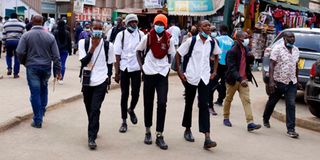Wrong to send students home for school fees

Secondary school students walking on the streets of Nairobi on June 2, 2021 after schools closed for midterm break.
What you need to know:
- The secondary school education cycle is a significant juncture in the national and educational development.
- But it faces the challenge of high dropout rates among the learners.
Globally, education is a basic human right that should be accessed free of charge, at least in the elementary and fundamental stages. To improve on school enrollment, the government rolled out free primary education and subsidised secondary schooling.
Governments around the world have invested huge amounts of their expenditure in education. Kenya is committed to elimination of poverty as a hindrance to educational development; promotion of human rights through provision of education; and attainment of sustainable development by the provision of quality universal basic education.
The introduction of Free Primary Education (FPE) scheme in 2003 and Subsidised Free Day Secondary Education (SFDSE) in 2008, and later 100 per cent transition from primary to secondary school, were aimed at higher retention of learners in school.
SFDSE was meant to address illiteracy, low-quality education, poor completion at the secondary level, high cost of education and poor community participation in education. This targeted the Millennium Development Goals (MDGs) and Education for All.
According to the SFDSE policy, the government is expected to meet Sh10,265 of the tuition fees per student, which was increased to Sh12,870 in 2014, while the parents would take care of the other requirements —such as lunch, transport and boarding fees, besides development projects. This was in line with the government’s commitment to address regional, special needs and gender disparities.
High dropout rates
The secondary school education cycle lasts four years. Recognised as the springboard to tertiary or higher education and training, it is a significant juncture in the national and educational development. But it faces the challenge of high dropout rates among the learners . One of the causes of that is inability to pay school fees due to poverty.
According to the Ministry of Education, 70 per cent of children who complete primary school transit to secondary school. Of these, nine per cent drop out of secondary school annually with only 30 per cent of the reminder progressing to either tertiary or higher learning institutions.
Every secondary school dropout is an unfulfilled objective, goal and dream for the individual and society. With all the investment in education by the stakeholders, it was not proper for Education CS George Magoha to order principals and head teachers to send away children with fee balances.
There are cases of students who committed atrocities for being sent home for school fees: One hanged himself and the other drove a four-inch nail into his principal’s head, seriously injuring him. Such students know very well that chances of going back to school are slim. Most parents have been deprived of an income by the pandemic.
Prof Magoha should rescind his order and, instead, look for a way to fund these students, even through sponsorship, or lower the cost of education. How can Kenyan children change the world, as opined by Nelson Mandela, if they are sent home?
Ms Onjoro, a PhD student Mount Kenya University, is director, Careers Organisaton. [email protected]





